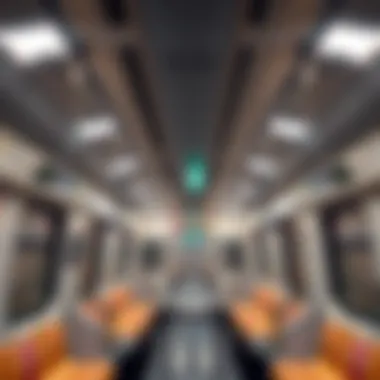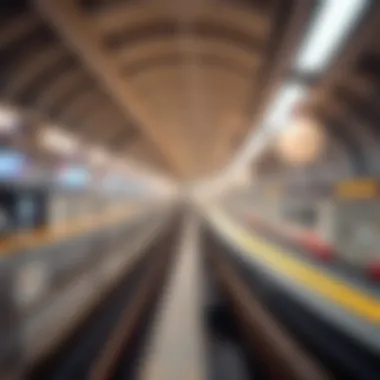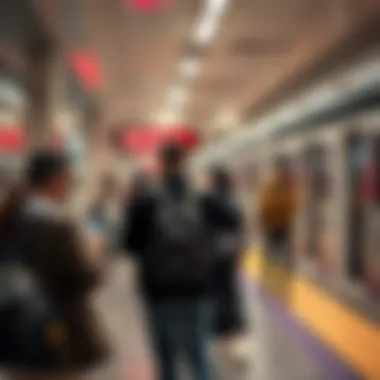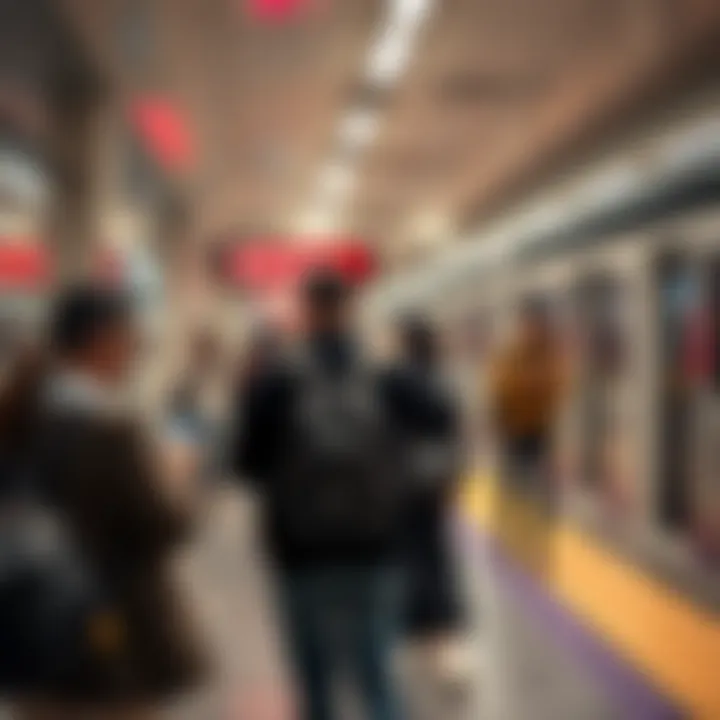Understanding the Costs of the Dubai Metro System


Intro
Dubai’s Metro system represents more than just a means of transportation; it epitomizes a critical infrastructure element for a city that’s rapidly evolving. Whether a resident catching the early morning train or a tourist soaking in the city’s marvels, understanding the costs associated with this vast network is essential. The pricing structure of the Dubai Metro ranges across a wide spectrum—there are various ticket options, smart card choices, and fare exemptions for particular groups. Exploring this enables a clearer insight into how the Metro improves urban mobility while also influencing the local economy and the real estate market.
In this exploration, we aim to dissect various elements of the Dubai Metro's pricing schema, alongside its lasting impact on the city’s demographics. By the end, you should feel equipped with a nuanced understanding of how transportation costs correlate with real estate investments, tourist spending habits, and urban development trends. Let's delve into these elements to uncover the broader implications for investors, residents, and visitors alike.
Intro to the Dubai Metro
The Dubai Metro represents more than just a mode of transportation; it epitomizes the transformation and modernization of urban mobility within this rapidly evolving city. Launched in 2009, the system has rapidly become foundational to commuters and tourists alike, owing to its functionality and efficiency. The significance of the Dubai Metro extends beyond its engineering marvel; it has turned into a crucial asset that addresses pressing transportation challenges in a city characterized by its fast-paced development and influx of residents from all over the globe.
Historical Context
The inception of the Dubai Metro must be viewed against the backdrop of a city that has aggressively pursued global competitiveness. After discovering oil in the 1960s, Dubai experienced a rapid economic boom, leading to an exponential rise in population and vehicular traffic. By the early 2000s, traffic congestion became a burgeoning concern. To tackle this dilemma, plans for a metro system were set into motion as part of Dubai's Vision 2020 initiative aimed at providing a sustainable transport solution. This pivotal decision acknowledges the historical socioeconomic shifts within the region, guiding Dubai to diversify its economy beyond oil dependency.
Today, the Metro stretches across key areas, connecting neighborhoods and significant landmarks, fostering greater interaction between different urban zones.
Current Significance in Urban Transport
Fast forward to present times, the Dubai Metro has attained heightened relevance in bolstering the city's public transport network. Designated lines span over 75 kilometers, with more routes anticipated as the city grows. The metro facilitates smooth transit for over 600,000 passengers daily, signifying its role as a life line for daily commuters and tourists.
The importance of the Dubai Metro is not limited to alleviating traffic woes; it serves a pivotal role in promoting sustainability and reduced carbon footprints in a city known for its lavish lifestyle. Moreover, with stations located strategically near commercial and residential hubs, it enhances the urban landscape, creating walkable communities and reducing dependency on cars.
"Public transport is not just about moving people; it's about shaping lives and creating opportunities."
For investors, understanding the dynamics of the Dubai Metro holds substantial weight. Integrating urban transport planning with real estate developments has been a game-changer, fueling property value increases along metro lines. As we delve into the pricing structure in subsequent sections, it's essential to grasp how these historical and current elements intertwine, leading us to a nuanced understanding of the metro's broader economic influence, especially as it pertains to the real estate market and urban development strategies.
Pricing Structure of the Dubai Metro
The pricing structure of the Dubai Metro is not merely a collection of ticket prices; it’s an essential part of understanding the city’s transport ecosystem. Given that many residents and visitors rely on this mode of transport for daily commuting, intentional pricing becomes critical in shaping travel behavior and economic accessibility. Moreover, when one contemplates the broader impacts of this pricing model, it reveals insights about the city’s commitment to sustainable urban mobility and equitable access to essential services.
Standard Ticket Prices
The standard ticket prices for the Dubai Metro are tiered based on the number of zones traveled. For a journey spanning only one zone, the ticket can cost around 3 dirhams, while moving across multiple zones increases the fare, up to a maximum of 8.5 dirhams for a longer trip that covers five zones. Such a structure nudges commuters towards understanding their commuting patterns, ensuring they make informed choices about their travel plans. For occasional users or tourists, purchasing a single-journey ticket can be convenient, but frequent travelers often find themselves better off with a Nol card due to the savings it offers.
Nol Card Options
The Nol card is a versatile payment solution that simplifies navigating the Dubai Metro and other modes of public transport. It comes in several types: silver, gold, blue, and red. The silver card, for instance, costs a nominal fee of 25 dirhams, which includes a 19 dirham balance available for travel. This card is particularly beneficial for regular users since it allows for seamless transfers among different modes of transportation, including buses and water taxis. Not having to worry about cash or ticket purchases makes it an appealing option for daily commuters as well as tourists looking for a hassle-free travel experience.
Discounts for Specific Groups
Students
For many students, public transport represents an economical way to travel around Dubai, especially given the high costs associated with tertiary education. Dubai Metro provides a substantial discount on fares for students, acknowledging their often limited budgets. With a government-issued student ID, they can secure a reduced fare option tailored to meet their financial needs. This approach makes the metro not just an affordable transit option, but a useful ally in encouraging students to explore various parts of the city without worrying about steep travel costs. The reduced prices help foster independence, allowing them to manage their transportation effectively during their university years.
Seniors
Seniors are another group that benefits significantly from the Metro's pricing structure. Residents aged 60 and above can avail themselves of discounted fares, which reflect an understanding of the needs of older residents. This discount does not just make it easier for them to access essential services across the emirate, but it also encourages social participation and mobility among this demographic. By waving the fare increases during off-peak hours, the metro aims to ensure that travel remains a part of their routine without becoming a financial burden.
People of Determination
People of Determination— a term used to describe individuals with disabilities— find an accommodating support structure in the Dubai Metro’s pricing model. They get free access to the Metro, acknowledging the barriers they may face in transportation. This initiative not only promotes inclusivity but also empowers them to travel independently throughout the city. The free fares eliminate financial obstacles, providing easier access to education, employment, and recreation, thereby enhancing their overall quality of life.


Variability of Prices by Zones
Understanding the variability of prices within the Dubai Metro system plays a crucial role in grasping the broader implications of urban transport economics. This aspect highlights the relationship between distance traveled and fare costs, making it an essential consideration for residents and visitors alike. Metro pricing, based on specific zones, caters to the diverse needs of commuters and aligns with sustainable urban mobility practices.
Explanation of Metro Zones
The Dubai Metro operates within a zoned fare system that categorizes different areas of the city into distinct zones. This method ensures that passengers pay fairly based on the distance they travel. For instance, if a commuter hops on at the Burj Khalifa station and travels to the Deira City Centre, the fare is calculated based on the number of zones crossed. Typically, the greater the distance—from Zone 1 to Zone 5—the higher the fare, reinforcing the principle of equitable pricing.
Moreover, within this zoned framework, various price tiers accommodate different traveling patterns.
- Single Journey Tickets: These are priced according to the zones.
- Nol Cards: Users can preload these cards, benefiting from discounts compared to single tickets, encouraging regular use of the Metro.
Understanding these zones also helps in urban planning and development, guiding infrastructure investments where demands are anticipated.
Impact of Distance on Fare
The direct correlation between distance and fare impacts not just how much passengers pay, but also reflects the operational costs of running the Metro. Longer trips necessitate more resources, from energy usage to train maintenance. As a result, the transport authority employs a distance-based pricing model that serves several purposes.
- Cost Efficiency: By charging more for longer trips, the Metro can justify its operating costs, ensuring sustainability.
- Encouragement of Short Trips: Pricing proximity can encourage quick, short trips, promoting the inner-city economy.
- Behavioral Insights: With this model, authorities can analyze travel patterns and adapt services to current passenger demands.
In essence, the distance-based pricing system fosters a balanced approach to urban transport, where passengers can weigh costs against convenience.
"With effective management of pricing and distance, the Dubai Metro continues to build a robust urban transport framework, catering to diverse commuter needs while encouraging sustainable practices."
Through understanding the zone-based pricing, both users and planners are empowered to make informed decisions, fostering an interconnected cityscape.
Comparison with Other Transport Modes
In evaluating the costs associated with the Dubai Metro system, it is crucial to draw comparisons with various transport modes available in the city. This provides a clearer picture of Dubai’s unique transportation landscape, allowing potential users and investors to make informed decisions. A well-rounded comparison not only highlights the strengths and weaknesses of the metro system but also the broader implications for the urban mobility ecosystem. The aspects being compared include reliability, convenience, pricing, and accessibility, all of which significantly affect the overall appeal of these transport options.
Cost Analysis Against Buses and Taxis
When looking at transport costs in Dubai, buses and taxis are two modes that often come into play. Buses generally serve as a more economical alternative to both the Dubai Metro and taxis.
- Bus Fare Structure: The cost of riding a bus is usually lower than metro fares, which notably appeals to budget-conscious commuters.
- Taxi Costs: Taxi fares, however, tend to escalate quickly, especially during peak hours, contributing to significant daily expenses for regular users. Moreover, taxis do not have a fixed price structure, as they rely on a meter that can vary according to traffic conditions.
In the interest of evaluating affordability, here’s a quick comparison:
- Buses: Average fare ranges from 3 to 6 dirhams per ride, depending on the distance covered.
- Taxis: Base fare starts around 12 dirhams, with incremental charges applied per kilometer, often surpassing the cost of metro travel for longer distances.
Ultimately, while buses offer a cheaper alternative, their reliability can vary, leading many to opt for the more consistent metro despite slightly higher fares.
"Whether for daily commutes or airport transfers, understanding these costs is key to assessing the real value of public transport in Dubai."
Metro vs. Ride-sharing Services
The rise of ride-sharing services in Dubai has added yet another layer to the transport choice dilemma for commuters. Companies like Uber and Careem have carved out a significant niche within the urban transport framework. In terms of pricing, ride-sharing can become a double-edged sword.
- Pricing Dynamics: Ride-sharing often operates on a flexible pricing model, which can lead to higher costs during surge periods, making it unpredictable compared to the consistent fare structure of the metro system.
- Convenience Factor: While ride-sharing offers door-to-door service, making it convenient for travelers who may have luggage or those traveling in groups, the costs can quickly add up, especially for those intending to travel frequently.
Some essential points to consider:


- Price per Ride: On average, ride-sharing costs start at around 15 to 20 dirhams for short trips but may soar beyond 50 dirhams for longer journeys.
- Versatility: Unlike the metro system, which has limited operational hours, ride-sharing services are available around the clock.
In summary, while ride-sharing services can be convenient, their varying costs may not be as economical in the long run compared to the Dubai Metro. Commuters weighing their options will need to consider not only immediate costs but also factors such as travel frequency, convenience, and the reliability of the transport modes they choose. Understanding these nuances can lead suburban residents and investors to a more nuanced perspective on the most practical transport method in Dubai.
Economic Implications of Metro Pricing
The pricing structure of the Dubai Metro goes well beyond the immediate cost of a ticket. It serves as a linchpin for various economic dynamics, influencing not just ride affordability but also broader elements like tourism and real estate. By exploring the economic implications of metro pricing, we can understand how this transport system plays a pivotal role in shaping Dubai's urban landscape and its appeal to different stakeholders.
Effect on Tourist Attractiveness
A well-structured pricing model can significantly enhance the attractiveness of a city to tourists. For instance, the Dubai Metro's affordable fares provide an economical option for visitors navigating the city’s attractions. When tourists can easily travel at a lower cost, they tend to spend more on experiences rather than transportation.
Consider this: a day pass on the metro allows visitors to explore landmarks like the Burj Khalifa and the Dubai Mall without breaking the bank. The ease of access leads to increased foot traffic in these areas, benefiting local businesses, cafes, and markets. Simply put, a tourist-friendly metro pricing structure can transform potential visitors into active customers, contributing to the vibrancy of the local economy.
"Transport isn't just about getting from A to B; it's about enhancing the entire experience of the destination."
Moreover, the simplicity of the Nol card system fosters a hassle-free experience for tourists. With options to load the card with various amounts and multiple fare choices, tourists are less likely to feel overwhelmed or put off by complex pricing schemes. As a result, a seamless metro experience bolsters Dubai's reputation as a welcoming destination.
Impact on Property Values
When it comes to property values, the Dubai Metro acts as a double-edged sword. On one hand, easy access to the metro increases the desirability of properties located near metro stations. Areas like Dubai Marina and Downtown Dubai witness a surge in property demand as buyers and renters prioritize proximity to reliable transportation. This demand naturally drives property prices upward, making it a favorable scenario for investors and developers alike.
Furthermore, the promise of improved accessibility from ongoing expansions of the metro network can mean increased property values even in less developed areas. Many believe that future stations will bring new life to neighborhoods that are currently overlooked, leading to speculation and interest in those properties. Investors looking to capitalize on an emerging market stand to gain from such trends.
However, the inverse effect must also be considered. If metro pricing remains too high, lower-income residents may find themselves unable to partake in the benefits of city improvements, leading to economic divides. This scenario could counteract the allure of a desirable metro-accessible location, placing pressure on policy-makers to strike a balance between affordability and accessibility.
Accessibility and Mobility Trends
The significance of accessibility and mobility trends in the context of the Dubai Metro cannot be overstated. As urbanization continues to escalate in this bustling metropolis, an efficient and accessible transport system plays a pivotal role in shaping the daily lives of its residents and visitors. This not only impacts their convenience but also influences broader socio-economic factors such as business development and property values.
Integration with Other Transport Systems
One core aspect of the Dubai Metro's accessibility is its seamless integration with other transport systems. The Metro is not an isolated mode of transport; rather, it operates in harmony with a variety of other services. Buses, taxis, and ride-hailing platforms like Uber and Careem complement the Metro’s reach.
- Connectivity: The Metro stations are strategically located near bus stations and popular taxi stands. This strategic placing encourages commuters to utilize multiple transport options. For instance, a passenger may board a bus to reach a Metro station, thereby optimizing their travel time.
- Nol Card Use: Utilizing the Nol Card allows travelers to switch between these various transport forms effortlessly. This ease of transition enhances the overall experience, making public transport a more attractive option compared to personal vehicles.
This integrated approach not only improves individual accessibility but also significantly reduces traffic congestion on the roads. As public transport emerges as a reliable alternative, the city can reshuffle priorities toward developing more walkable neighborhoods, thereby benefiting residents.
Influence on Urban Planning
Urban planning is greatly influenced by accessibility trends stemming from the Dubai Metro. The presence of a reliable public transport backbone facilitates thoughtful urban design that promotes density and sustainability.
- Zoned Development: Areas surrounding Metro stations tend to experience a boom in property development. These zones often attract businesses and housing projects due to their easy access to public transport, promoting growth in property values. Developers are now more likely to build mixed-use developments that combine residential, commercial, and leisure spaces in proximity to Metro stations.
- Sustainability Goals: The Dubai government aims to adhere to sustainability goals, and by leveraging the Metro’s efficient design, they can minimize urban sprawl. This means ensuring that amenities such as grocery stores, schools, and recreational areas are easily reachable by foot or via the Metro.
Furthermore, these planning strategies enhance the quality of life for residents, making neighborhoods more livable and vibrant. In an era where environmental concerns are at the forefront, prioritizing public transport through thoughtful urban planning reflects a progressive mindset.
"A robust Metro system in Dubai is akin to a backbone; it supports and stabilizes the city's structure while ensuring accessibility for everyone."
Challenges in Pricing Strategy
A functional pricing strategy is a cornerstone for any urban transport system, especially a complex one like the Dubai Metro. Pricing is not merely about setting fare prices; it is about constructing a framework that enables sustainable operations, while catering to a diverse range of passengers—from daily commuters to occasional tourists. The challenges faced in this domain are multifaceted, intertwining economic realities with public perception.


To start, there’s the delicate balancing act between maintaining affordability for residents and ensuring enough revenue for operational costs. Dubai Metro serves a broad spectrum of users, which means pricing must reflect this diversity. Understanding the implications of fare structures, ticket options, and discounts is vital. Affordability alone is not the only concern; the pricing model must also instill confidence in its riders about the quality and reliability of the service.
Furthermore, competition from different transport modes—like taxis, ride-sharing, or buses—adds another layer of complexity. If the Metro fares lean too heavily towards premium pricing, it risks losing ridership to more affordable alternatives. The strategy then becomes one of attracting and maintaining a loyal customer base without appearing overly profit-driven. This is crucial, as a well-utilized Metro system not only eases road congestion but also enhances the overall travel experience in the city.
"Pricing should not just serve as a mechanism for revenue, but as a lever for growth, accessibility, and sustainability in urban mobility."
Maintaining Affordability
Keeping fares accessible is a primary consideration in the pricing strategy of the Dubai Metro. There are numerous reasons behind this focus. First, affordability directly affects ridership numbers; if fares are reasonable, more people are likely to opt for the Metro over personal vehicles or taxis. In a city geared towards sustainability and reduction of traffic congestion, this is a significant objective.
To maintain affordable pricing, the Dubai authorities must constantly evaluate operational costs and assess how potential fare increases can impact their ridership. It’s not just about calculating expenses; understanding the socio-economic demographics of passengers shapes decisions. For instance, students and low-income groups greatly benefit from special fare rates, illustrating an effort to make public transport accessible.
Consider the scenarios where Ciel and Faha, two friends living in different parts of Dubai, rely on the Metro daily. While Ciel is a student, Faha holds a well-paying job. Keeping Ciel's student discounts substantial means he can continue using the Metro without financial strain, while still ensuring services are not compromised for riders like Faha.
Addressing Public Feedback
Public feedback serves as a pulse check for the Dubai Metro's pricing strategy. Engaging with the community allows transport authorities to glean insights into customer satisfaction and areas for improvement. Failure to pay attention to this feedback could result in policies that don't resonate with the public, ultimately harming ridership and the reputation of the Metro.
Different platforms—social media, community forums, or public surveys—provide opportunities for passengers to express their thoughts. Such input can influence decisions on fare changes, service improvements, and even new routes. For instance, if a significant number of commuters indicate that certain metro lines are crowded or the pricing structure is confusing, authorities can act on this data. By doing so, they demonstrate responsiveness and adaptability, thus fostering trust among users.
Future of the Dubai Metro Pricing
The fate of the Dubai Metro pricing system is crucial for multiple stakeholders, including not just the commuters, but also investors, urban planners, and government agencies. As the city's population burgeons, along with its real estate and tourism industries, the need for a robust, adaptable pricing structure becomes more critical. A forward-looking approach to pricing is essential for ensuring that the Metro remains accessible while also contributing to Dubai's growth.
Predicted Changes in Fare Structure
As Dubai continues to progress, expected changes in fare structure may center around flexibility and targeted pricing strategies. One major factor will be the anticipated growth in ridership due to influxes of both tourists and expatriates. With such rising numbers, the Metro must adapt its fare system to accommodate varying passenger needs and behaviors.
- Dynamic Pricing Models
As seen in other global cities, dynamic pricing models, which adjust fares based on demand, could come into play. For instance, peak hours might attract higher fares while off-peak rides could be subsidized, drawing in more users during quieter times. - Group Discounts
A more engaging fare system might also include special group discounts. This could incentivize travel for families or corporate teams, thereby enhancing the whole commuting experience. - Subscription Services
A possible introduction of monthly or yearly subscription services may emerge too, catering to daily commuters who rely on the Metro for their transport needs. Such subscriptions could ensure steady revenue and encourage long-term patronage.
Long-term Economic Strategies
The Metro’s future pricing strategy is not just about maintaining a balance between accessibility and profitability; it’s also about long-term economic planning. The relationship between transport costs and economic activity is profound. Here are several considerations:
- Enhancing Connectivity
By ensuring fares remain reasonable, the Dubai Metro can stimulate real estate value along its routes. Increased connectivity generally leads to a rise in property prices and rental income in adjacent neighborhoods, thus benefiting property owners and investors alike. - Encouraging Sustainable Commuting
An ongoing focus on keeping transport costs manageable helps promote sustainable commuting. This not only reduces congestion but also aligns with broader environmental initiatives, showcasing Dubai as a forward-thinking metropolis willing to invest in its public transport. - Government Initiatives for Affordability
Consideration should also be given to how government subsidies can play a role in future fare settings. Strategic investment from the government could buffer against drastic price hikes, ensuring that transportation remains affordable for all citizens.
In sum, as the city forges ahead, it is paramount that the Dubai Metro adopt a pricing strategy that embraces adaptability while taking into account diverse economic impacts. Doing so will not only fulfill immediate transport needs but also contribute to the enduring economic health of this thriving metropolis.
"Creating a transportation framework that accounts for both present demands and future ambitions is critical for a city like Dubai, where change is the only constant."
For further reading on dynamic pricing models and sustainable transport, check out resources such as Wikipedia and Britannica for a comprehensive overview.
Closure
In summarizing the complexities surrounding the Dubai Metro's pricing structure, it’s clear that understanding its costs goes beyond just fare prices. The Metro acts as a lifeline in this bustling metropolis, shaping urban mobility while influencing economic factors that benefit various stakeholders.
Recap of Key Points
- The pricing structure incorporates multiple ticket options and card systems tailored to meet the needs of diverse passenger groups.
- Economic implications of these fare structures are significant, impacting tourists, residents, and even property values within metro vicinity.
- Accessibility is enhanced through integration with other transport modes, ensuring that the Metro remains a pivotal part of Dubai's urban transport landscape.
- The challenges in maintaining affordability while addressing public feedback are ongoing, indicating the need for a dynamic approach in pricing strategies.
Final Thoughts on the Dubai Metro's Role
Looking ahead, the Dubai Metro is more than just a transit system; it plays a crucial role in the fabric of the city. As the population grows and urban planning evolves, the Metro's pricing will likely adapt to meet these changes. Its success hinges not only on efficiency and convenience but also on how well it remains accessible to all. The future of the Dubai Metro, therefore, is not just about managing costs; it’s about sustaining its value for investors, residents, and the increasing numbers of expatriates. This interconnectedness of transport and economy makes it a vital subject worth further exploration.
In essence, the costs associated with the Dubai Metro are woven into the broader narrative of urban development and economic vitality in this vibrant city.
For detailed information, please check out resources such as Wikipedia and Dubai's Official Government Website.



